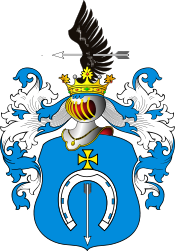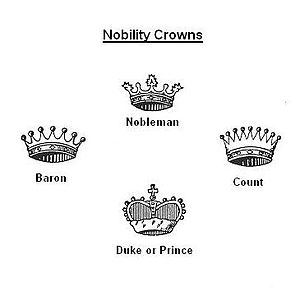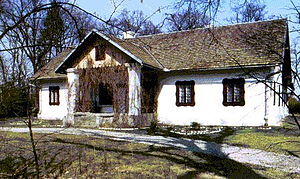- Dołęga coat of arms
-
Dołęga (pronunciation: [dɔˈwɛ̃ɡa]) is a Polish Coat of Arms. It was used by several szlachta families in the times of the Polish-Lithuanian Commonwealth.
Contents
Blazon
Azure, a downward opened horse-shoe argent with a cross former of the same charged on the edge of its arch. Inside the horse-shoe an argent arrow whose downward point protrudes. Helmet with mantling azure, lined argent. Crowned. Crest: a vulture's wing with an argent arrow shot through.
There were three versions of Dołęga Coat of Arms:-
Count (Hrabia) - In Russia and Poland, where the title of count was not introduced until Peter The Great's (1672–1725) time, it came to be given usually to officials of a certain rank in the government service. In Poland there were no Counts before the partitions of the late 18th century, when the title was introduced by the Russians, Austrians, and Prussians. The early Komes title was developed in medieval Poland. A Count's crown usually has nine points above its shield.
Baron - Nobility title that is lower than the Count, but is higher than a nobleman. The Baron's crown have usually seven points on the crown. (while noblemen only three, Dukes and Princes are decorated with Mitre). .
Nobleman - The lowest title has three points on his crown.
History
This coat-of-arms appears in 1345, as the seal of Mysliborz, a Judge of Dobrzyn (Dobrzyń nad Wisłą).
In a 1373 manuscript of Jan, the Bishop of Płock, the village of Łeg is first mentioned as a Dołęga Clan possession.
It is surrounded by villages once owned by Dołęga Clan families. These are: Dabrowa, Dziedzice, Grabow, Gzino, Koskowo, luzniewo, Mlice, Osiek, Ossowa, Zakrzewo, Zalesie, and others, owned respectively by the Dabrowski, Dziedzicki, Grabowski, Gzinski, Koskowski, luzniewski, Mlicki, Osiecki, Ossowski, Zakrzewski, and Zaleski families etc. These villages and Płock are in the Masovian region of east Poland.
A court record of 1373 describes the war cry as "Do Langa". In records after 1400 the two words merge as "Dolanga," then more recently as Dołęga. "Do łęga" means "To Łeg!" and perhaps served as a rallying point in times of conflict, or for the local clan celebrations.
Others say Dołęga means "To Bows" a cry to arms as the enemy approached. Another source says the word Dołęga in old Polish, meant potent - having great physical strength, forcefullness.
Some state that the origin of the coat of arms originated in the war of the King Boleslaw Krzywousty (1102–1139) against Prussia. A knight Dołęga of the coat of arms Pobog shot an arrow that killed the Prussian leader. This led to the people of Poland to rise up to attack. As a reward Dołęga received the arrow to its coat of arms Pobog, and the new coat of arms was called after him.
There is a village named Prusy which ostensibly for purposes of inheritance, was divided up among Dołęga Clan members. The name of this village may have given rise to the 'myth', that at one time, Dołęga clansmen might have defeated and captured Prussian (Baltic-speaking) enemies, and reduced them to serfs on their various properties.
Also there is a village called Dołęga in Małopolskie district of southern Poland which has a well preserved nineteenth-century szlachta noble manor house (now a museum) surrounded by a natural forest park, in which there is a small chapel built by the nobleman owner. It was quite common for the nobleman to provide money/men to build the village church or chapel depending on size and riches of the family.
Notable bearers
Notable bearers of this Coat of Arms include:-
- Maria Skłodowska-Curie
- Zorian Dołęga-Chodakowski
- Erazm Józef Dołęga-Jerzmanowski
- General Mikołaj Bołtuć family
- Tadeusz Dołęga-Mostowicz. Przydomek "Dołęga", wzięty z rodowego herbu matki, przybrał w latach dwudziestych
- Dołęga-Ossowski family
- Dołęga-Mycielski family
- Dołęga-Zaleski family
- Tadeusz Mazowiecki
- Paweł Włodkowic
- Paulus Vladimiri Dołęga
- Jan Dołęga-Zakrzewski
- Stefan Kubaska, Frieherr
- Stefan Dolega-Lewandowski
- Roch Kossowski
References
- Herbarz Polski by Stupnicki, Hipolit. Figaro Press, (London 1963).
- Z dziejow Nosarzewskich herbu Dołęga z Ziemi Zawkrzanskiej by Lech Jablonski (Warsaw 2001).
- Herbarz Polski by Adam Boniecki (1st Edt), Marek Jerzy Minakowski (2nd Edt 2004)
- Herby Rodów Polskich and Rycerstwo Polskie Wieków Srednich by Franciszek Piekosinski
See also
- Polish heraldry
- Heraldry
- Coat of Arms
- Coat of arms of Dąbrowski I - variation of Dołęga
- [1] - Polish Nobility (Polska Szlachta)
- Szczepanski family
Categories:- Polish coats of arms
Wikimedia Foundation. 2010.



